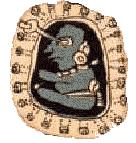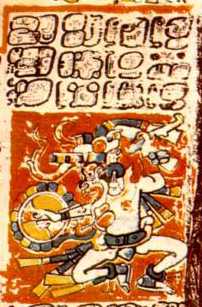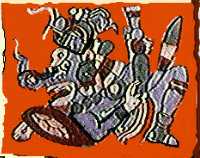 Maya skywatcher (Madrid Codex, p.34)
observing with viewing tube. The symbols about the figure are similar to icons known to
represent stars in Central Mexican codices.
Maya skywatcher (Madrid Codex, p.34)
observing with viewing tube. The symbols about the figure are similar to icons known to
represent stars in Central Mexican codices.Mayan Astronomy
| We will soon admire the accomplishments of Ptolemy, who collected accurate measurements of the sky and developed a model of the motions of the planets that was used for nearly 15 centuries. Maya astronomers also made remarkably accurate measurements. The accomplishments of these early astronomers seem incredible, but what they lacked in sophisticated technology and accurate instruments, they made up by patient observing over long periods of time. Here is a comparison of four basic periods of motion of celestial bodies, showing that both Ptolemy and the Mayas came incredibly close to the modern, accurate values. Ptolemy, in the second century A.D., used observations made by Hipparchus (2nd century B.C.) and Babylonian astronomers of the 5th and 6th centuries B.C. as well as his own to calculate average values of astronomical periods, combining some 800 years of observations. From the accuracy they achieved, it seems likely that the Maya astronomers had access to equivalently long records of observations. |  Maya skywatcher (Madrid Codex, p.34)
observing with viewing tube. The symbols about the figure are similar to icons known to
represent stars in Central Mexican codices. Maya skywatcher (Madrid Codex, p.34)
observing with viewing tube. The symbols about the figure are similar to icons known to
represent stars in Central Mexican codices. |
| Modern (days) | As recorded by the Maya | Maya in days | Ptolemy | |
| Lunar (synodic) month | 29.53059 | 405 lunations = 46 tzolk'ins (260 x 46 = 11,960 days) | 29.53086 | 29.53337 |
| Synodic period of Venus | 583.93 | 301 periods = 676 tzolk'ins ( 260 x 676 = 175,760 days) | 583.92027 | 583.94267 |
| Synodic period of Mars | 779.94 | 1 period = 3 tzolk'ins (3 x 260 = 780 days) | 780 | 779.94 |
| Solar (tropical) year | 365.24198 | 1507 tropical years = 1508 haabs (365 x 1508 days) | 365.242 | 365.24667 |
 |
 |
Here is a Mayan astronomical "instrument." At the tropical latitudes of the Mayan cities, the sun passes directly over head twice per year. Very accurate timing could be achieved by determining just when this happened - sort of like setting your watch. To the far left is a vertical zenith sighting tube, and to the left is the structure that allows access to its other end under ground. Careful observation would have set the time to a minute or so. This zenith tube is at the site of Xochicalco, pictures from C. Ruggles, |
We are fortunate that the accomplishments of the Maya were recorded because they had also developed a written language. However, we are unfortunate that so few of their writings have survived. The Spanish conquerors were appalled at the religious practices of the meso-Americans and viewed anything connected with religion, definitely including the writings about astronomy, as evil and to be destroyed. Only a few examples of the Maya codices survived, perhaps snatched by curious Spanish soldiers from piles about to be put to the torch, and smuggled back in luggage tucked into nooks in their tiny sailing ships. These codices are now named after the European cities where they eventually re-appeared.
 |
Probably the best preserved is the Dresden Codex. (From GBonline http://pages.prodigy.net/gbonline/awmayac.html).It
is a detailed account of the astronomical observations of the Mayas. The Maya sought to
understand the repetitive cycles of motions of the moon and planets, and thus to be able
to predict when these bodies would be in certain places on the sky in the future. To allow
such predictions, the Maya also developed a sophisticated number system, of base 20
(compared with our base 10 system). Their observations were used by their priests to
indicate to the meso-American rulers propitious times for various actions. Indeed,
their whole calendar played a critical role in identifying important occasions, tied to
many-year cycles of the base 20 numbering. The Dresden Codex contains:
|
Venus rising in the morning was thought to set the stage for success in war, and since the meso-Americans seemed to be nearly always preparing for or carrying out raids on each other, this planet received a huge amount of attention from the Maya astronomers.
| The Dresden Codex Venus pages display three sets of deities: (1) Gods ruling each apparition (right). The deity who rules when Venus is morning star is illustrated at the top right of each page. (2) The gods who represent Venus' malign influence (middle right), illustrated as warriors, armed with spears, in the middle right of each page. (3) The victims of Venus (far right). These deities are illustrated at the lower right, often pierced with spears. You can identify a set of these three images along the right edge of the full page in the box above, also. |  |
 |
 |
 |
Here is a particularly beautiful version of a Venus deity spearing its victim, from the Borgia Codex. |
The huge effort and accurate measurements of the Maya do not seem to be applied toward an effort to understand how or why the sky appears as it does. Instead, the heavens are treated as an immense, accurate piece of clockwork that is used in the same sense as the signs of astrology, to predict the future. We can admire the technical skills of the Maya astronomers, be awed by the resources their society put into their temple/observatories, and even speculate that, given time, they might have produced a genius who would have bent their effort into a more scientific direction. However, so far as it went, their astronomy was a scientific dead end.
(Material from Michael John Finley Saskatoon, Saskatchewan, Canada) http://members.shaw.ca/mjfinley/astronomers.html